Junkers Ju 90
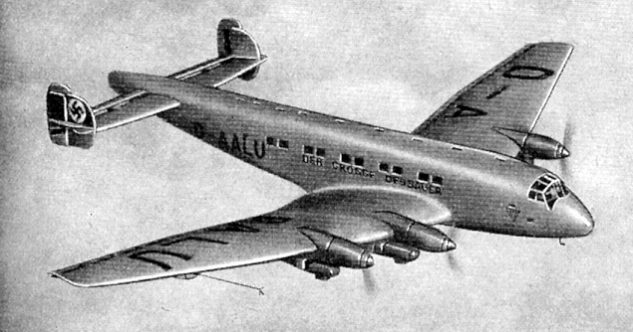 Junkers Ju 90 V1 "Der Grosse Dessauer"
Junkers Ju 90 V1 "Der Grosse Dessauer"
auteur inconnu - author unknown
Le Junkers Ju 90 était un quadrimoteur de transport développé à partir du Junkers Ju 89, projet de bombardier lourd abandonné par les allemands. Le Ju 90, initialement utilisé par la Lufthansa (D.L.H. : Deutsche Luft Hansa), fut par la suite également utilisé par la Luftwaffe.
The Junkers Ju 90 was a four-engined transport aircraft developed from the Junkers Ju 89, a project of long-range bomber rejected by the Germans. The Ju 90, initially used by the Lufthansa (D.L.H. : Deutsche Luft Hansa), was later used also by the Luftwaffe.
 Junkers Ju 90 - photo dans le domaine public - photo in public domain
Junkers Ju 90 - photo dans le domaine public - photo in public domain
Des Junkers Ju 90 pour la Lufthansa
Junkers Ju 90s for the Lufthansa
 Junkers 90 - photo : source inconnue - source unknown
Junkers 90 - photo : source inconnue - source unknown
Dans les années 30, la Deutche Luft Hansa (DLH) utilisait beaucoup le Junkers Ju 52/3m. Mais cet avion n'était pas suffisamment performant pour les long parcours, notamment face à des concurrents comme le DC 3 américain. La DLH décida donc de se doter de quadrimoteurs. Elle s’intéressa ainsi au développement par la Luftwaffe du bombardier Junkers Ju 89.
In the 30's, the Deutsche Luft Hansa (DLH) used mostly the Junkers Ju 52/3m. But this aircraft was not enough performing for long-range flights, especially in front of competitors such as the American Douglas DC-3. The DLH then decided put a request for four-engined airliners. It looked at the development by the Luftwaffe of the bomber Junkers Ju 89.
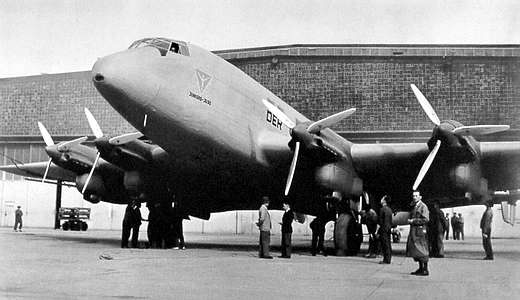 Junkers Ju 90 V1 "Der Grosse Dessauer" - photo source inconnue - source unknown
Junkers Ju 90 V1 "Der Grosse Dessauer" - photo source inconnue - source unknown
Quand ce projet fut abandonné, la Lufthansa utilisa dès 1935 le 3ème prototype du Ju 89 pour des essais. La queue et les ailes furent conservées mais le fuselage fut élargi pour permettre l’accueil de 40 passagers. Le développement du Junkers Ju 90 débuta donc en janvier 1936 et le premier vol du prototype V1 (ex prototype Ju 89 V3) eut lieu le 28 août 1937. Le V1 fut détruit lors de vol d'essai le 7 février 1938.
When this project was given up, the Lufthansa used in 1935 the 3rd prototype of the Ju 89 for tests. The tail and wings were kept but the fuselage was widened to welcome 40 passengers. The development of Junkers Ju 90 began in January, 1936 and the maiden flight of the V1 prototype (ex Ju 89 V3 prototype) was on August 28th, 1937. The V1 was destroyed during a test flight on February 7th, 1938.
 Junkers Ju 90 V1 - photo source inconnue - source unknown
Junkers Ju 90 V1 - photo source inconnue - source unknown
C'est donc le V2 que la Lufthansa essaya (D-AIVI "Preussen" - W. Nr. 4914) en mai et juin 1938 pendant 100 heures de vol. En novembre 1938, le "Preussen" devait effectuer un vol de démonstration vers Buenos-Aires (Argentine). Mais le 26 novembre, il se crasha lors du décollage de Bathurst (Gambie) à destination de Dakar (Sénégal) après avoir heurté un palmier suite vraisemblablement à la panne d'un (ou de deux ?) moteur(s) ; 12 personnes à bord furent tuées sur 15 passagers dont les pilotes et co-pilotes, les capitaines Robert Untucht et Joachim Blankenburg.
It is then the V2 (D-AIVI " Preussen " - W. Nr. 4914) which the Lufthansa tested in May and June, 1938 during 100 hours of flight.In November, 1938, the "Preussen" had to make a demonstration flight towards Buenos-Aires (Argentina). But on November 26th, it crashed after take-off at Bathurst (Gambia) for a flight towards Dakar (Senegal), by touching a palm tree, probably because of a failure with one (or two?) engine (s) ; 12 persons on board were killed out of 15 passengers among whom the pilot and co-pilot, captains Robert Untucht and Joachim Blankenburg.
 Junkers 90 - photo : source inconnue - source unknown
Junkers 90 - photo : source inconnue - source unknown
Malgré ces accidents, la DLH commanda 8 Junkers Ju 90 (série A-1) et utilisa également les V3 et V4. Le V3 ("Württemberg" puis D-AURE "Bayern"), déjà en service à la DLH depuis juillet 1938, fut ensuite temporairement rattaché à la 10./TG 172 lors de la crise des Sudètes (automne 1938).
Despite these accidents, the DLH ordered 8 Junkers Ju 90 (serie A-1) and also used the next two prototypes V3 and V4. The V3 ("Württemberg" then D-AURE "Bayern"), already used by the DLH since July, 1938, was later temporarily allocated to the 10./TG 172 during the crisis of the Sudetes (autumn, 1938).
 Junkers Ju 90 V3 "Bayern" - D-AURE © LuftArchiv.de
Junkers Ju 90 V3 "Bayern" - D-AURE © LuftArchiv.de
 Junkers Ju 90 D-ABDG "Würtemberg" & D-ASND "Mecklenburg" © LuftArchiv.de
Junkers Ju 90 D-ABDG "Würtemberg" & D-ASND "Mecklenburg" © LuftArchiv.de
Au total, la DLH commanda donc 12 Junkers Ju 90 parmi lesquels le D-ADFJ "Baden" (W.Nr. 0003) livré le 20 mai 1939, le D-ASND "Mecklenburg" (W.Nr. 0006) livré le 28 juin et le D-AEDS "Preussen" (W.Nr. 0005) livré le 21 juillet. Sur la commande de 8 Ju 90 série A-1, 7 furent livrés jusqu’en avril 1940 et le 8ème fut livré directement à la Luftwaffe.
Finally, the DLH ordered a total of 12 Junkers Ju 90 among whom the D-ADFJ " Baden " (W.Nr. 0003), delivered on May 20th, 1939, the D-ASND "Mecklenburg" (W.Nr. 0006) delivered on June 28th and the D-AEDS "Preussen" (W.Nr. 005) delivered on July 21st. On the order of 8 Ju 90 series A-1, only 7 were delivered until April, 1940 and the 8th was directly delivered to the Luftwaffe.

 Junkers Ju 90 A - photo source inconnue - source unknown
Junkers Ju 90 A - photo source inconnue - source unknown
La South African Airways commanda également 2 Junkers Ju 90 A-1 équipés de moteurs Pratt & Whitney Twin Wasp. Ceux-ci furent finalement livrés à la Luftwaffe.
Un 11ème modèle de la série A, incomplet, fut utilisé pour fabriquer le Ju 290 V1.
The South African Airways ordered also 2 Junkers Ju 90 A-1 fitted with engines Pratt and Whitney Twin Wasp. These were finally delivered to the Luftwaffe.
A 11th A series model, uncompleted, was used to develop the Ju 290 V1.
 Junkers Ju 90
Junkers Ju 90
Usine de Dessau, Allemagne, 1938. Dessau plant, Germany, 1938.
© Bundesarchiv Bild 146-1980-003-31
(Cette image est soumise aux droits de Creative Commons Attribution ShareAlike 3.0 Germany License)
(This picture is licensed under Creative Commons Attribution ShareAlike 3.0 Germany License)
Les Junkers Ju 90 : développement militaire
Junkers Ju 90 : military development
En avril 1939, le Reich Luft Ministerium (RLM), demanda à Junkers de développer un avion de transport sur la base du Ju 90. Ces avions furent les Junkers Ju 90 série B. Les Ju 90 V5 et V6 furent les prototypes de ce développement militaire : les ailes furent modifiées pour plus d’envergure (+19 %) et de surface alaire (+11 %). Le train d'atterrissage fut renforcé avec des roues avant jumelées.
In April, 1939, the Reich Luft Ministerium (RLM), asked Junkers to develop a transport aircraft based on the Ju 90. These aircrafts were the Junkers Ju 90 B series. The Ju 90 V5 and V6 were the prototypes of this military development : the wings were modified for greater span (+19 %) and area (+11 %). The landing gear was strengthened with twin front wheels.
 Junkers Ju 90
Junkers Ju 90
Probablement le V8 équipé d'une tourelle de mitrailleuses.
Probably the V8 with its machine guns turret.
photo source inconnue - source unknown
Une rampe de chargement fut ajoutée dans le plancher pour charger le matériel. Le V5 vola pour la première fois le 5 décembre 1939. Finalement le V6 fut utilisé pour le développement du Ju 390, tandis que les V7 et V8 servirent à celui du Ju 290. Le développement des V9 et V10 fut annulé.
A boarding ramp was added in the floor for freight loading. Finally the V6 was used for the development of the Ju 390, whereas V7 and V8 were used to develop the Ju 290. The development of V9 and V10 was cancelled.
 Junkers Ju 90 V7 'GF+GH'- photos : source inconnue - source unknown
Junkers Ju 90 V7 'GF+GH'- photos : source inconnue - source unknown
Versions - Variants
(StKz = Stammkennzeichen > Code usine - Plant code - VKz = Verbandskennzeichen > Code unité - Unit code)
Les 4 premiers Ju 90 étaient dotés de 5 paires de fenêtres rectangulaires sur les côtés, tandis que les Ju 90 B (prototypes V5 à V10) furent équipés de 10 paires de hublots ronds. Le Ju 90 V-6 fut modifié pour devenir le prototype Ju 390 V1. Le Ju 90 V8 devint le Ju 290 V2. Le Ju 90 V7 devint le Ju 290 V3.
The first 4 Ju 90 were designed with 5 pairs of rectangular windows on each side, and the Ju 90 Bs (prototypes V5 to V10) were equipped with 10 pairs of round portholes. The Ju 90 V-6 was modified to become the prototype Ju 390 V1. The Ju 90 V8 became the Ju 290 V2. The Ju 90 V7 became the Ju 290 V3.
Junkers Ju 90 A-1
Ju 90 V1 (ex Ju 89 V3) - D-AALU "Der Grosse Dessauer"
W.Nr. 4913, 4 moteurs DB 600 (1 050 CV). Premier vol le 28 août 1937. Détruit lors de vol d'essai le 7 février 1938.
W.Nr. 4913, 4 engines DB 600 (1 050 HP). Maiden flight on August 28th, 1937. Destroyed during a test flight on February 7th, 1938.
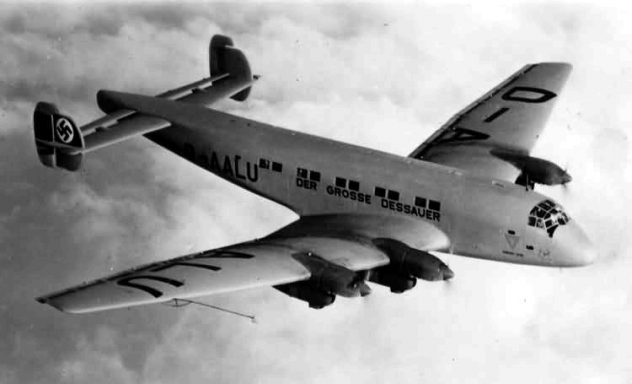
 Junkers Ju 90 V1 - photos : source inconnue - source unknown
Junkers Ju 90 V1 - photos : source inconnue - source unknown

 Junkers Ju 90 V1 "Der Grosse Dessauer" - photo source inconnue - source unknown
Junkers Ju 90 V1 "Der Grosse Dessauer" - photo source inconnue - source unknown
Ju 90 V2 - D-AIVI "Preussen"
W.Nr. 4914, 4 moteurs BMW 132 H/1 (830 CV). Livré à la Lufthansa le 26 mai 1938. Détruit au décollage à Bathurst (Gambie) le 26 novembre 1938 (12 personnes sur 15 tuées).
W.Nr. 4914, 4 engines BMW 132 H/1 (830 HP). Delivered to the Lufthansa on May 26th, 1938. Destroyed during take off at Bathurst (Gambia) on November 26th, 1938 (12 people out of 15 killed).
 Junkers Ju 90 V2 'D-AIVI' - photo source inconnue - source unknown
Junkers Ju 90 V2 'D-AIVI' - photo source inconnue - source unknown
 Junkers Ju 90 V2 'D-AIVI' - photo source inconnue - source unknown
Junkers Ju 90 V2 'D-AIVI' - photo source inconnue - source unknown
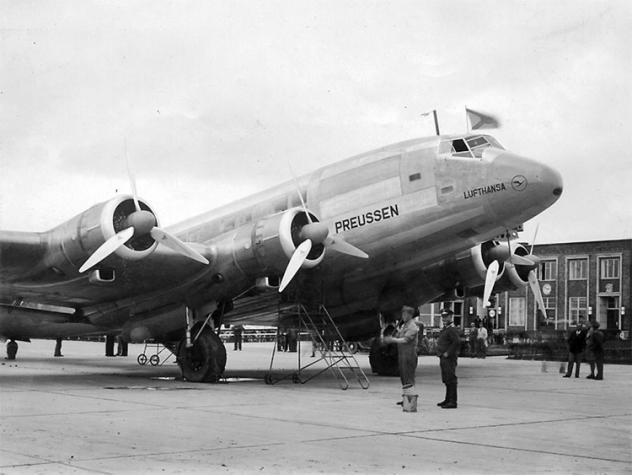 Junkers Ju 90 V2 'D-AIVI' Preussen - photo source inconnue - source unknown
Junkers Ju 90 V2 'D-AIVI' Preussen - photo source inconnue - source unknown

Ju 90 V3 - D-AURE 'Bayern'

Ju 90 V3 - 'D-AURE' Salavaza (Carcassonne), 1941 © Famille Anfriani - Anfriani family
Photo prise en fraude par le grand-père de Monsieur Renaud Schamber.
Photo taken in secret by the grand-father of Mister renaud Schamber
W.Nr. 4915 (StKz GF+GD), 4 moteurs BMW 132 H/1. En service à la Lufthansa puis au 10./TG 172. En septembre 1943, le D-AURE est accidenté à Barcelone. les dégâts sont minimes. Il fut détruit le 9 août 1944, vers 10h45, lors de l'attaque aérienne de l'aérodrome de Stuttgart-Echterdingen (Allemagne) par 6 P-38 Lightning.
W.Nr. 4915 (StKz GF+GD), 4 engines BMW 132 H/1. Used by Lufthansa and then allocated to 10./TG 172. In September, 1943, the D-AURE crashed in Barcelona (Spain) but damages were not important. It was destroyed on 9th August, 1944, at 10.45 am, during the attack of Stuttgart-Echterdingen airfield (Germany) by 6 Lightning P-38.


 Ju 90 V3 - 'D-AURE' photo : source inconnue - source unknown
Ju 90 V3 - 'D-AURE' photo : source inconnue - source unknown
 Ju 90 V3 - dessin : source inconnue - profile : source unknown
Ju 90 V3 - dessin : source inconnue - profile : source unknown
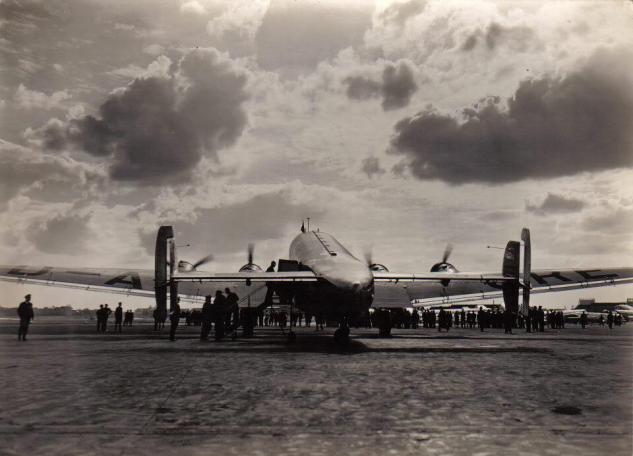 Junkers Ju 90 "Bayern" photo : source inconnue - source unknown
Junkers Ju 90 "Bayern" photo : source inconnue - source unknown
 Ju 90 'Bayern' - Berlin, Tempelhof, 1938 - photo : source inconnue - source unknown
Ju 90 'Bayern' - Berlin, Tempelhof, 1938 - photo : source inconnue - source unknown
Ju 90 V4 - D-ADLH "Sachsen" (LVSt. Rangsdorf > G6+BY, LVGr. Berlin LTS 290 > J4+DH)
W.Nr. 4916 (StKz KH+XA), 4 moteurs BMW 132 H/1 puis fin 1942 4 moteurs Jumo 211 F (1 200 CV). Affecté à Grossetto (Italie) au sein du LTS 290 le 28 mars 1943. Au sein du Transportfliegerstaffel 5 fin 1943.
W.Nr. 4916 (StKz KH+XA), 4 engines BMW 132 H/1 then late 1942, 4 engines Jumo 211 F (1 200 HP). Allocated to Grossetto (Italy) in the LTS 290 on March 28th, 1943. In the Transportfliegerstaffel 5 late 1943.

Junkers Ju 90 B
Ju 90 V5 - D-ANBS (ABNS ?) "Preussen"
W.Nr. 4917 (StKz KH+XB), 4 moteurs BMW 132 M (970 CV).
W.Nr. 4917 (StKz KH+XB), 4 engines BMW 132 M (970 HP).
 Junkers Ju 90 V5 - W.Nr. 4917 - D-ANBS
Junkers Ju 90 V5 - W.Nr. 4917 - D-ANBS
Plus tard le KH+XB - Later KH+XB © LuftArchiv.de
Ju 90 V6 - D-AOKD
W.Nr. 4918 (StKz KH+XC), 4 moteurs BMW 139 (1 500 CV) puis utilisé en 1942 pour construire le Ju 390 V1.
W.Nr. 4918 (StKz KH+XC), 4 engines BMW 139 (1 500 HP) then used in 1942 to develop the Ju 390 V1.
Ju 90 V7 - D-APFH / GF+GH / J4+CH (?)
W.Nr. 4919 (StKz GF+GH), 4 moteurs BMW 801 A (1 560 CV). Devint le troisième prototype du Ju 290 (V3). Premier vol le 6 septembre 1941.Il fut également envoyé sur le front de l'Est. Détruit le 5/10/1944.
W.Nr. 4919 (StKz GF+GH), 4 engines BMW 801 A (1 560 HP). Became the third Ju 290 prototype (V3). Maidden flight on 6th September 1941. It was also sent on the Eastern front. Destroyed on 5/10/1944.
 Junkers Ju 90 V7
Junkers Ju 90 V7
Grosseto, Italie, mars-avril 1943 - L'avion à l'arrière plan pourrait être le V7 et celui au premier plan le V8 (avec la tourelle de mitrailleuses).
Grosseto, Italia, Marche - April, 1943 - The aircraft in the background could be V7 and the one in the foreground the V8 (with machine gun turret).
© Seeger, Erwin - Bundesarchiv Bild 101I-561-1130-39A
(Cette image est soumise aux droits de Creative Commons Attribution ShareAlike 3.0 Germany License)
(This picture is licensed under Creative Commons Attribution ShareAlike 3.0 Germany License)
 Ju 90 V7 - 'GF+GH' photo : source inconnue - source unknown
Ju 90 V7 - 'GF+GH' photo : source inconnue - source unknown

 Junkers Ju 90 V7 'J4+CH'
Junkers Ju 90 V7 'J4+CH'
Février 1944, Riga-Spilve (Lettonie) - February 1944, Riga-Spilve (Latvia).
photo : source inconnue - source unknown
Ju 90 V8 - D-AQJA > J4+BH
W.Nr. 4920 (StKz DJ+YE), 4 moteurs BMW 801. Fut équipé de tourelles de mitrailleuses (1xMG-151 et 5xMG-131) dans la perspective de devenir un bombardier. Aurait volé la première fois en septembre 1941. Devint finalement le second prototype du Ju 290 (V2).
W.Nr. 4920 (StKz DJ+YE), 4 engines BMW 801. Was fitted with machine gun towers to become a bomber. Flew first in September 1941. Became finally the second Ju 290 prototype (V2).
 Ju 90 V8 - D-AQJA - © Srecko Bradic www.letletlet-warplanes.com
Ju 90 V8 - D-AQJA - © Srecko Bradic www.letletlet-warplanes.com
 Junkers Ju 90 V8 - W.Nr. 4920 - DJ+YE, LTS 290
Junkers Ju 90 V8 - W.Nr. 4920 - DJ+YE, LTS 290
© LuftArchiv.de

 Junkers Ju 90 V8 - photos : source inconnue - source unknown
Junkers Ju 90 V8 - photos : source inconnue - source unknown
Ju 90 V9 & V10
Programmés mais projet abandonné au début de la guerre et prototypes jamais fabriqués.
Programmed but project dropped at the beginning of the war and prototypes never buit.
"Klein Serie" ("Petite série" - "Little serie")
W.Nr. 900001à 900010, 8 avions pour la Lufthansa avec moteurs BMW 132 H/1 et 2 avions pour la South African Airlines avec moteurs Pratt & Whitney Twin Wasp SC-G 1 200 CV (W.Nr. 0002 et 0004). Ces modèles furent appelés Z-3 pour les distinguer des Z-2 motorisés BMW. Ces deux avions furent finalement livrés à la Luftwaffe. Un 11ème modèle de la série A, incomplet, fut utilisé pour fabriquer le Ju 290 V1.
W.Nr. 900001to 900010, 8 units for Lufthansa with engines BMW 132 H/1 and 2 units for the South African Airlines with engines Pratt and Whitney Twin Wasp SC-G 1 200 HP (W.Nr. 0002 and 0004). These units were designated Z-3 to distinguish them from the BMW-powered Z-2.These 2 aircrafts were finally delivered to the Luftwaffe. A 11th A series model, uncompleted, was used to develop the Ju 290 V1.
Ju 90 A-1 - D-ABDG 'Württemberg' - W.Nr. 900001 (StKz KH+XC ou/or GF+GB)
Le Ju 90 D-ABDG 'Württemberg' revint à la DLH le 24 avril 1945 en provenance de l'Erprobungstelle (E-Stelle) de Tarnewitz (Allemagne). Il fut capturé par les Britanniques à Travemünde en mai 1945 puis fut ferraillé.
The Ju 90 D-ABDG 'Württemberg' returned to the DLH on April 24th, 1945, back from the Erprobungstelle (E-Stelle) of Tarnewitz (Germany). It was captured by the British at Travemünde in May, 1945 and was later clattered.
 Junkers Ju 90 D-ABDG "Württemberg" photo : source inconnue - source unknown
Junkers Ju 90 D-ABDG "Württemberg" photo : source inconnue - source unknown
 Junkers Ju 90 D-ABDG "Württemberg" photo : source inconnue - source unknown
Junkers Ju 90 D-ABDG "Württemberg" photo : source inconnue - source unknown
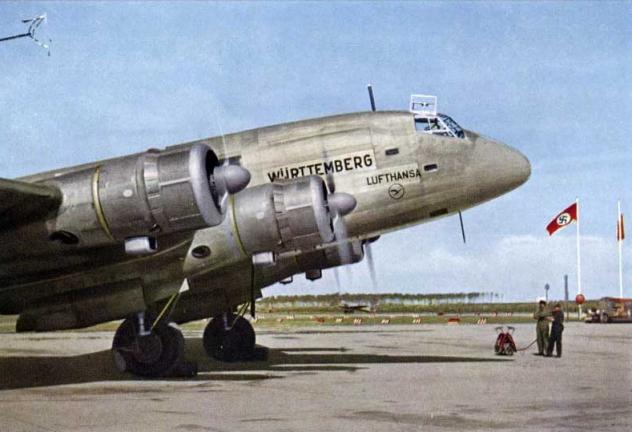 Junkers Ju 90 "Württemberg" © LuftArchiv.de
Junkers Ju 90 "Württemberg" © LuftArchiv.de
 Junkers Ju 90 D-ABDG "Württemberg" - photo : source inconnue - source unknown
Junkers Ju 90 D-ABDG "Württemberg" - photo : source inconnue - source unknown
Ju 90 A Z-3 - D-APZR - StKz GF+GE ou/or KB+LA - VKz J4+EH - W.Nr. 900002
Jamais livré à la South African Airways sous le code ZS-ANG.
Never delivered to South African Airways as ZS-ANG.
Ju 90 A Z-2 - D-ADFJ 'Baden' - StKz GF+GA - VKz J4+FH - W.Nr. 900003
Affecté à Grossetto (Italie) au sein du LTS 290 le 28 mars 1943. Détruit le 20 mai 1943 lors du bombardement du terrain par des B-17 de la Northwest African Strategic Air Force (NASAF).
Allocated to Grossetto (Italy) in the LTS 290 on March 28th, 1943. Destroyed on May 20th, 1943 during the bombardment of the airfield by B-17s of the Northwest African Strategic Air Force ( NASAF).
 Junkers Ju 90 A Z-2 'GF+GA' - photo : source inconnue - source unknown
Junkers Ju 90 A Z-2 'GF+GA' - photo : source inconnue - source unknown
 Junkers Ju 90 J4+FH
Junkers Ju 90 J4+FH
Après le bombardement du 20 mai 1943. After the bombardment, on 20th May, 1943.
photo : source inconnue - source unknown
Ju 90 A Z-3 - W.Nr. 900004 StKz KB+LB
Jamais livré à la South African Airways sous le code ZS-AHN. Le 12 avril 1940, l'avion, trop chargé de munitions, s'écrasa au décollage et brula. Mais l'équipage survécut (Pilote : Oberleutnant d. R. Graf Schack von Wittenau)
Never delivered to South African Airways as ZS-AHN. On 12th April, 1940, the aircraft, overloaded with ammunitions, crashed during take off and burned out. The crew survived (Pilot : Oberleutnant d. R. Graf Schack von Wittenau).
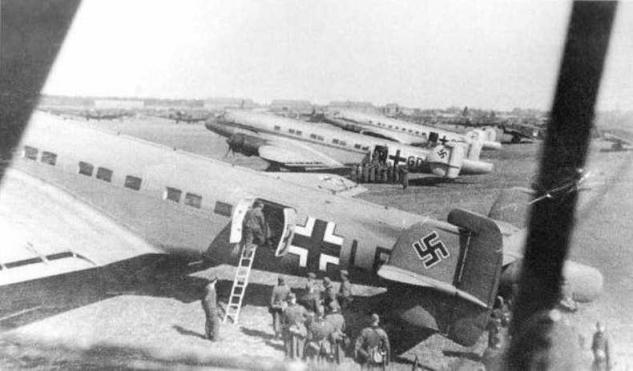 Junkers Ju 90 KB+LB, Neumünster
Junkers Ju 90 KB+LB, Neumünster
9 avril 1940 - Ju 90 D-AURE "Bayern" GF+GD au second plan.
9th April 1940 - Ju 90 D-AURE "Bayern" GF+GD in background
photo : source inconnue - source unknown
Ju 90 A Z-2 - D-AEDS 'Preussen' - StKz GF+GE - VKz J4+GH - W.Nr. 900005
Affecté à Grossetto (Italie) au sein du LTS 290 le 28 mars 1943. Utilisé pour l'évacuation de la Crimée en avril 1943.
Allocated to Grossetto (Italy) in the LTS 290 on March 28th, 1943. Used for Crimea evacuation in April, 1943.
 Junkers Ju 90 J4+GH 'Preussen'
Junkers Ju 90 J4+GH 'Preussen'
L'équipage de l'Ofw Liesche devant l'appareil, Olbia (Italie), été 1943.
Ofw Liesche's crew in front of the aircraft, Olbioa (Italy), summer 1943.
photo : source inconnue - source unknown
Ju 90 A Z-2 - D-ASND 'Mecklenburg' - StKz BG+GX - VKz J4+HH - W.Nr. 900006
Affecté à Grossetto (Italie) au sein du LTS 290 le 28 mars 1943. En novembre 1943, après le retour en Bavière, l'appareil fut perdu dans des circonstances inconnues.
Allocated to Grossetto (Italy) in the LTS 290 on March 28th, 1943. In November, 1943, after the return in Bavaria, the aircraft was lost in unknown circumstances.
 Junkers Ju 90 D-ABDG "Würtemberg" & D-ASND "Mecklenburg"
Junkers Ju 90 D-ABDG "Würtemberg" & D-ASND "Mecklenburg"
photo source inconnue - source unknown
 Junkers Ju 90 D-ASND "Mecklenburg" - photos source inconnue - source unknown
Junkers Ju 90 D-ASND "Mecklenburg" - photos source inconnue - source unknown
 Junkers Ju 90 D-ASND "Mecklenburg" - photos source inconnue - source unknown
Junkers Ju 90 D-ASND "Mecklenburg" - photos source inconnue - source unknown
 Junkers Ju 90 D-ASND "Mecklenburg" - photos source inconnue - source unknown
Junkers Ju 90 D-ASND "Mecklenburg" - photos source inconnue - source unknown
 Junkers Ju 90 D-ASND "Mecklenburg" - photos source inconnue - source unknown
Junkers Ju 90 D-ASND "Mecklenburg" - photos source inconnue - source unknown
Ju 90 A Z-2 - D-AFHG 'Oldenburg' - StKz BD+TX ou/or BD+GY - VKz J4+JH - W.Nr. 900007
Affecté au Lufttransportstaffel 290 (LTS 290) le 16 novembre 1942, il se retrouve à Grossetto le 28 mars 1943. Le J4+JH est touché le 22 (ou 23) juillet 1943 au large de Bastia en Corse par le Martin Marauder piloté par le Wing Commander W.S.G. Maydwell, Commandant du Squadron N°14 puis définitivement abattu par la flak amie au dessus de Bastia.
Allocated to the Lufttransportstaffel 290 (LTS 290) on November 16th, 1942, it is sent at Grossetto (Italy) on 28th March, 1943. The J4+JH was damaged on July 22, (or 23) 1943, off Bastia, Corsica (France), by Wing Commander W.S.G Maydwell, the Commanding Officer of No. 14 Squadron and definitely shot down by the friend Flak over Bastia.
 Junkers Ju 90 D-AFHG 'Oldenburg'
Junkers Ju 90 D-AFHG 'Oldenburg'
Lors d'un ravitaillement en Suède. Refuelling in Sweden.
photo : source inconnue - source unknown
 Junkers Ju 90 J4+JH - W.Nr. 900007 - Le 22 (ou 23) juillet 1943 - On July 22nd (or 23rd), 1943.
Junkers Ju 90 J4+JH - W.Nr. 900007 - Le 22 (ou 23) juillet 1943 - On July 22nd (or 23rd), 1943.
photo dans le domaine public - photo in public domain
Ju 90 A Z-2 - D-ATDC 'Hessen' - StKz BG+GZ - W.Nr. 900008
Perdu le 30 janvier 1943 à l'atterrissage à Charkow (Russie) : trop endommagé pour être réparé, il fut sabordé pour ne pas tombé aux mains des soviétiques.
Lost on January 30th, 1943 when landing in Charkow (Russia) : too damaged to be repaired, it was destroyed to avoid the capture by Soviet troops.
Ju 90 A Z-2 - D-AJHB 'Thüringen' - StKz BJ+OV VKz J4+KH W.Nr. 900009
Affecté à la Luftwaffe le 16 novembre 1942 (Luftverkehrs-Gruppe Berlin) puis affecté à Lecce (Italie). Lors du vol de transfert vers l'Italie du Sud, l'avion fut frappé par la foudre au dessus de la Yougoslavie et se posa à Foggia (pilote : Leutnant Otto Puhrmann). Il dut retourner à Berlin pour être réparé. Affecté à Grossetto (Italie) au sein du LTS 290 le 28 mars 1943. Il retourne en Bavière en novembre 1943 puis est cédé à la Erprobungstelle (E-Stelle), une unité d'essai, en décembre. Sa trace est perdue en 1944.
Allocated to the Luftwaffe on November 16th, 1942 (Luftverkehrs-Gruppe Berlin) then sent to Lecce (Italy). During the flight towards Southern Italy, the aircraft was struck by a lightning over Yugoslavia and landed at Foggia (pilot : Leutnant Otto Puhrmann). It had to return in Berlin to be repaired. Allocated to Grossetto (Italy) in the LTS 290 on March 28th, 1943. It moved back to Bavaria in November, 1943 and was then allocated to the Erprobungstelle (E-Stelle), a testing unit, in December. Its track is lost in 1944.
 Junkers Ju 90 "Thüringen" (W. Nr. 0009) - Lufthansa, 1939
Junkers Ju 90 "Thüringen" (W. Nr. 0009) - Lufthansa, 1939
© Dekker Art Work (Thierry Dekker) : http://dekker-artwork.blogspot.fr
 Junkers Ju 90 "Thuringen" (W. Nr. 0009) - Lufthansa, 1941-1942
Junkers Ju 90 "Thuringen" (W. Nr. 0009) - Lufthansa, 1941-1942
© Dekker Art Work (Thierry Dekker) : http://dekker-artwork.blogspot.fr
 Junkers Ju 90 'J4+KH' 'Thuringen'
Junkers Ju 90 'J4+KH' 'Thuringen'
Juin 1943, Sardaigne. June, 1943, Sardinia.
photo : source inconnue - source unknown
 Junkers Ju 90 "Thuringen" (W. Nr. 0009) - Lufttransportstaffel 290, Juin 1943 - June 1943
Junkers Ju 90 "Thuringen" (W. Nr. 0009) - Lufttransportstaffel 290, Juin 1943 - June 1943
© Dekker Art Work (Thierry Dekker) : http://dekker-artwork.blogspot.fr
Ju 90 A - 'Brandenburg' - W.Nr. 900010
Les Junkers Ju 90 en action
Junkers Ju 90 in action
Les Ju 90 de la Lufthansa furent progressivement utilisés dès 1940 par la Luftwaffe, comme avions de transport. Ce fut aussi le cas du V4 une fois équipés de moteurs Jumo 211 F. Le dernier avion de la Lufthansa fut perdu lors d'une attaque aérienne sur Stuttgart le 9 août 1944. Au total, les avions de la DLH volèrent 3,8 millions de kms. A partir d'avril 1940, les avions de la DLH furent utilisés pour transporter du minerai de tungstène entre Vienne, Viterbo (Italie) et Barcelone ainsi que de l'étain de l'Espagne vers l'Allemagne. Le 8 novembre 1940, le Ju 90 'D-AVMF' s'écrasa pour des raisons de givrage à Braunau en Autriche : les 23 passagers et 6 membres d'équipage furent tués.
The Ju 90 of Lufthansa were gradually used by the Luftwaffe in 1940 as transport aircraft. The V4 was also used by Luftwaffe when fitted with Jumo 211 F engines. The last Lufthansa aircraft was lost during an aerial attack over Stuttgart, on August 9th, 1944. In total, the DLH aircrafts flew 3.8 million kms. From April 1940, the DLH aircrafts were used to carry tungsten ore between Vienna, Viterbo (Italy) and Barcelona as well as tin from Spain to Germany. On 8th November 1940, the Ju 90 'D-AVMF' crashed for icing reasons in Braunau, Austria : 23 passengers and 6 crew members were killed.

Junkers Ju 90 "D-ADFJ" "Baden" - GF+GA. - 4./KGzbV 107.
Oslo (Norvège), mi-1940 - Oslo (Norway), mid-1940.
photo source inconnue - source unknown
La Luftwaffe utilisa les Junkers Ju 90 sur de nombreux théâtres d'opération : 4 (ou 5 ?) Ju 90 furent utilisés comme avions de transport pour l'invasion du Danemark et de la Norvège au sein du 4./KGzbV 107 en 1940. Trois Ju 90 avec des équipages de Lufthansa furent utilisés par la Luftwaffe pour des transports de soutien de l'insurrection irakienne contre les forces d'occupation britanniques en 1941. Deux autres avions furent utilisés comme avions de remorquage de planeurs Messerschmitt Me 321.
The Luftwaffe used Junkers Ju 90 in many operation theaters : 4 (or 5 ?) Ju 90 were used as transport aircrafts during the invasion of Denmark and Norway in the 4./KGzbV 107 in 1940. Three Ju 90 with Lufthansa crews were used by the Luftwaffe for transportation support of the Iraqi insurgency against British occupation forces in 1941. Two other aircrafts were used to tow Messerschmitt Me 321 gliders.
 Junkers Ju 90 "V-7" & Messerschmitt Me 321
Junkers Ju 90 "V-7" & Messerschmitt Me 321
photo source inconnue - source unknown
En Février 1942, tous les Ju 90 disponibles furent utilisés pour des vols d'approvisionnement sur le front Est. En Novembre 1942, les Ju 90 étaient utilisés pour des transports en Méditerranée, avant de revenir en Janvier 1943 pour approvisionner Stalingrad. Puis les Ju 90 furent affectés au Lufttransportstaffel (LTS) 290 avant de revenir en juillet 1943 à Mühldorf am Inn (Bavière) quand l'Afrique du Nord fut perdue par les Allemands.
In February 1942, all available Ju 90 were used to supply the Eastern Front. In November 1942, the Ju 90 were used for transport in the Mediterranean region, before returning in January 1943 to supply Stalingrad. Then the Ju 90 were assigned to Lufttransportstaffel (LTS) 290 before returning in July 1943 in Mühldorf am Inn (Bavaria) when North Africa was lost by the Germans.
 Junkers Ju 90 Z-2 W.Nr. 900006, D-ASND
Junkers Ju 90 Z-2 W.Nr. 900006, D-ASND
© LuftArchiv.de
Le LTS 290 devint la Tr.fl.St. 5 (Transportfliegerstaffel) en décembre 1943 puis 14./TG4 en août 1944. Il servit successivement à l'évacuation de la Crimée (début 1944), puis de la Grèce (septembre et octobre 1944). 18 Junkers Ju 90 en tout furent fabriqués : 16 furent détruits avant la fin de la guerre et les deux autres, capturés par les alliés, furent également détruits peu de temps après. Au total, les Ju 90 volèrent 222 902 kms, aussi bien sous les couleurs de la Lufthansa que de celles de la Luftwaffe.
The LTS 290 LTS became Tr.fl.St. 5 (Transportfliegerstaffel) in December, 1943 and 14./TG4 inAugust, 1944. It was successively used for the evacuations of Crimea (early 1944) and Greece (September and October 1944). 18 Junkers Ju 90 in total were built : 16 were destroyed before the end of the war and the other two captured by the Allies, were also destroyed shortly after. In total, the Ju 90 flew 222 902 km, under the colors of Lufthansa as well as those of Luftwaffe.



